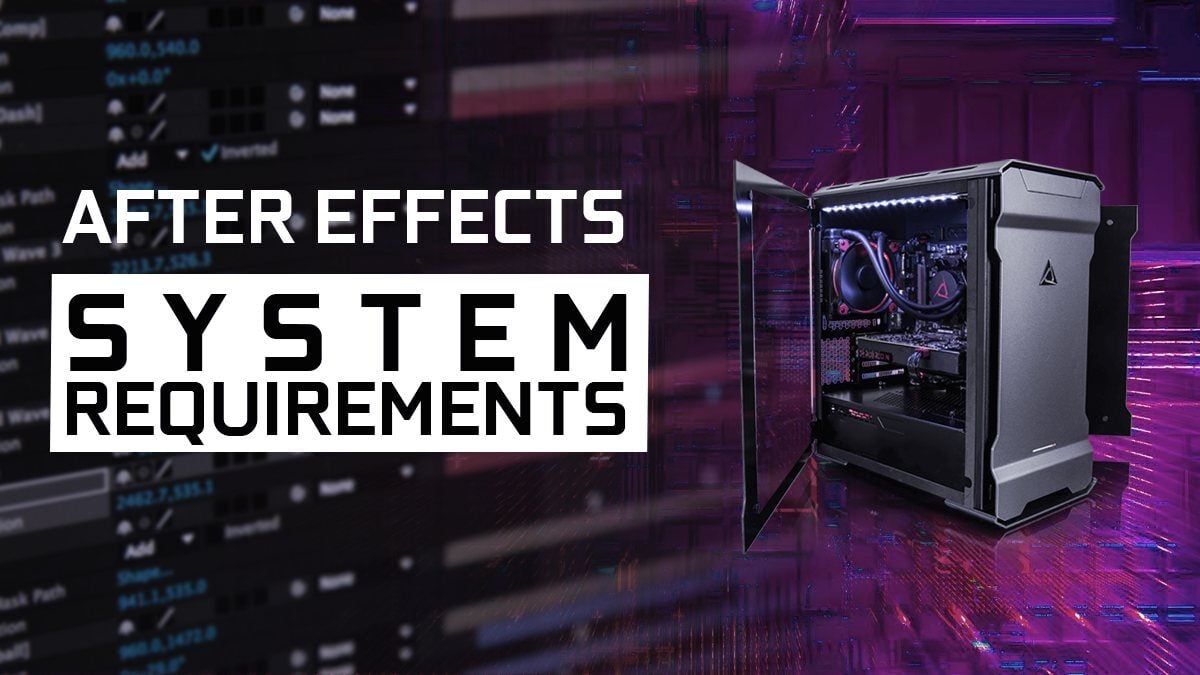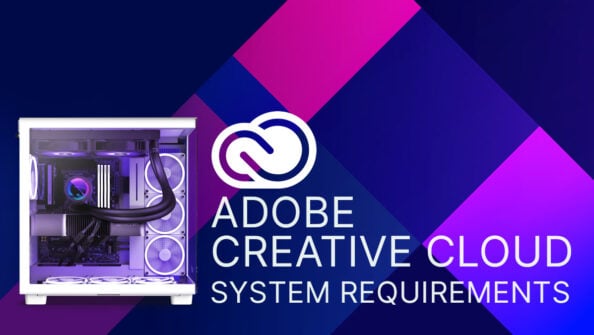TABLE OF CONTENTS
Adobe After Effects is one of the most popular Motion Design & Compositing software on the market. Although it’s also widely used for VFX, its areas of application in visual effects are somewhat limited – but well suited for beginners.
After Effects is considered a VFX software with a broad market appeal, but it still demands a lot of performance from your computer. As always, there are several ways and levels to use an application, and your performance needs will depend a lot on the complexity of your projects.
In any case, if you’re a professional After Effects user, you’ll need a PC that doesn’t limit your productivity.
Whether you’re upgrading a PC to run After Effects or want to see if your computer can run the VFX program, here’s everything you need to know.
Official After Effects System Requirements
So what PC Components does Adobe recommend for After Effects?
Listed below are the minimum and recommended system requirements for After Effects.
Adobe listed out the system requirements for multiple After Effect versions, but for simplicity’s sake, we’ll use their latest available specifications—After Effects CC 2018 (15.1). Check out Adobe’s official list for the system requirements of the previous After Effects versions.
Windows System Requirements
| Components | Minimum Requirements | Recommended Requirements |
|---|---|---|
| Processor | Multicore Intel processor with 64-bit support | |
| Operating System | Windows 7 with Service Pack 1 (64 bit) | Windows 8.1 (64 bit), Windows 10 (64 bit) |
| RAM | 8 GB | 16 GB or more |
| Hard disk | ~6 GB of available space and 5+ GB for disk cache | ~6 GB available space (SSD) and 10+ GB for disk cache |
| Monitor resolution | 1280x1080 display | 1920 x 1080 display |
| GPU | Optional: Any Adobe-Certified GPU Card (CUDA or Quadro) |
macOS System Requirements
| Components | Minimum Requirements | Recommended Requirements |
|---|---|---|
| Processor | Multicore Intel processor with 64-bit support | |
| Operating System | macOS El Capitan (10.11) | macOS Sierra (10.12), macOS High Sierra (10.13) |
| RAM | 8 GB | 16 GB or more |
| Hard disk | ~6 GB of available space and 5+ GB for disk cache | ~6 GB available space (SSD) and 10+ GB for disk cache |
| Monitor resolution | 1440x900 display display | 1920 x 1080 display |
| GPU | Optional: Any Adobe-Certified GPU Card (CUDA or Quadro) |
Our Take On the Official After Effects System Requirements
The minimum and recommended system requirements don’t look too bad, right? Well, there’s a catch.
It’s ideal for Adobe to keep their minimum system requirements as low as possible, to maximize the number of customers buying their software. Unfortunately, you’ll quickly hit a wall of performance issues if you’re running After Effects on a PC that barely satisfies the minimum recommendations.
After Effects’ performance demand will increase proportionally to the complexity of your projects. Factors like Color Bit Depth, Resolution, Footage Type (RAW, compressed), Number of Layers, and especially, Effects are just a few of many aspects that impact your PC’s After Effects performance.
Sure, you’ll be able to do some simple motion design or low-resolution compositing, but that’s where the fun stops. Increasing your resolution and composition bit-depth, adding effects to your layers, or working on something more complex like Image-tracking, Stabilization, Expression-heavy compositions or even 3D World-building within After Effects will make your PC slow down to a crawl.
It’s wise to keep in mind that Adobe’s official system requirements are most likely extremely outdated, especially as it doesn’t make sense for them to be recommending Intel CPUs when AMD is currently leading the CPU market in both single and multi-core performance.
A responsive and snappy interface is key to maximizing your productivity, so here’s an overview of hardware components that affect After Effects’ performance the most:
- CPU: An extremely high-clocking CPU will boost Active work performance, but Passive work, like rendering and exporting your compositions, benefits more from many cores. We found the sweet spot to lie at around 16 cores that clock fairly high (e.g. Ryzen 5950X). In short, try to get a CPU that is both high-clocking and has a decent number of cores but anything past 16 cores is usually wasted on After Effects alone.
- RAM: After Effects consumes a large amount of RAM. If you can afford it, we recommend jumping up to at least 32 GB of RAM (64 GB if possible). With hi-res comps at high bit-depths (32bit), you can even fill up 128GB of RAM without any problem.
- GPU: You can get away with a lower-tier GPU like the NVIDIA GTX 1660 Super since After Effects relies on the CPU more than the GPU unless you are using GPU accelerated effects (native effects or GPU supported Plugins like NeatVideo Denoiser ..) or do 3D work.
Our PC Build Recommendation For After Effects
If your workplace is stationary, the best performance is with a desktop PC built specifically for Adobe After Effects.
Here’s an excellent PC-Built for After Effects that will perform well even on complex projects:
If you’re looking for a complete breakdown of the best PCs for After Effects, be sure to check our in-depth guides:
Check Your Specs To See If Your Computer Can Run After Effects
You’ll want to check whether your computer can run After Effects, before upgrading or building a new PC. To do that, check your computer’s specifications. You can head on over to our complete guide on how to check your PC’s specs to do just that.
How to Upgrade Your PC to Run After Effects Faster
Upgrading your PC can be cumbersome, but we’ve done all the leg work for you.
If you’re looking for the best hardware components for your workstation or want to build a PC from scratch, you can check out our PC-Builder tool. You can easily set a budget and get the best-value PC components for your available budget.
If you’d rather keep most of your components but want to upgrade some of them, here’s an in-depth article on upgrading your PC as well:
Laptop Recommendations for After Effects
Laptops are a great choice for Visual Effects artists who like to work on the go. If you value mobility, check out our guide on finding the Best Laptop for Animation.
Conclusion: Adobe After Effects System Requirements
Adobe’s After Effects system requirements are outdated and most likely kept as low as possible to make a maximum number of people buy After Effects.
This might be fine for absolute beginners, but such minimum specs won’t hold up for more professional and complex workloads. If you’re looking to do some more heavy lifting in After Effects – above beginner level -, use our build guides to get an After Effects workstation that’ll keep you productive, motivated, and ahead of your competition.
That’s about it! Let me know in the comments or in our forum what kind of PC you’d like to purchase or upgrade. We’re happy to help!



![Adobe Animate System Requirements and PC Recommendations [2024 Update] Adobe Animate System Requirements and PC Recommendations [2024 Update]](https://www.cgdirector.com/wp-content/uploads/media/2023/06/Adobe-Animate-System-Requirements-and-PC-Recommendations-Twitter-594x335.jpg)
![Solidworks System Requirements & PC Recommendations [2024 Update] Solidworks System Requirements & PC Recommendations [2024 Update]](https://www.cgdirector.com/wp-content/uploads/media/2023/05/Solidworks-System-Requirements-PC-Recommendations-Twitter-594x335.jpg)

0 Comments